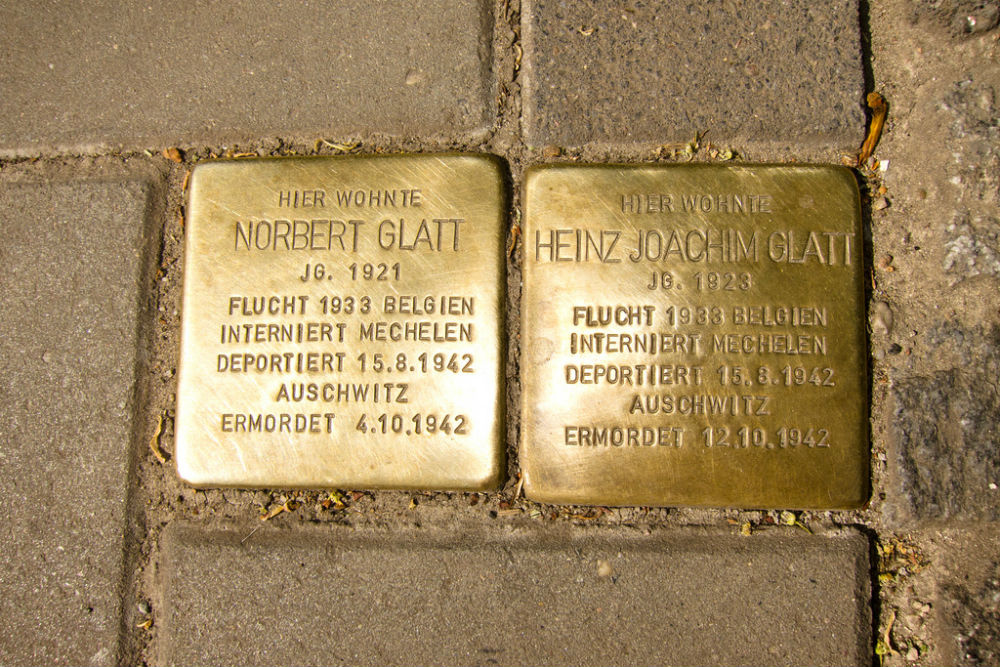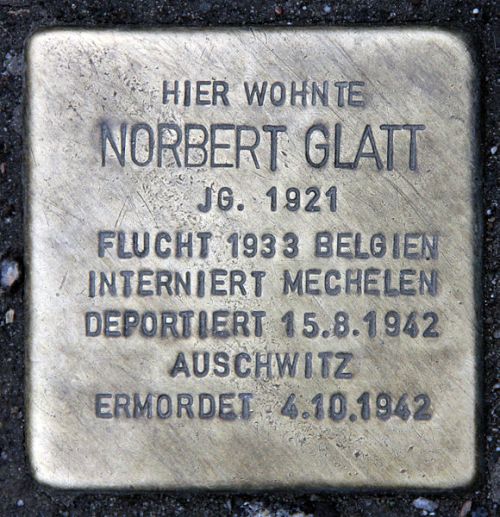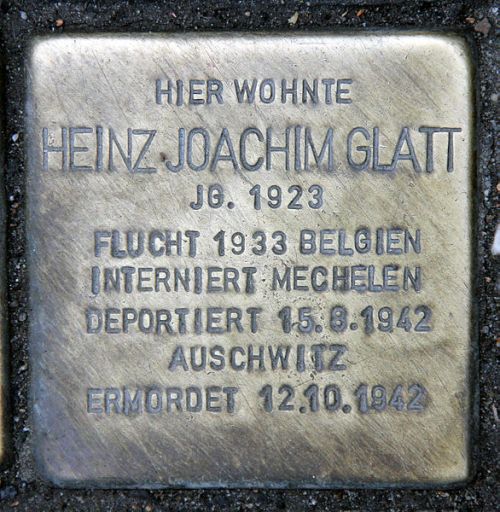Stumbling Stones Annenstraße 3
These small, brass memorial plaques (Stolpersteine or stumbling stones) commemorate:
* Norbert Glatt, born 1921, fled 1933 to Belgium, interned Mechelen, deported 15 August 1942, Auschwitz, murdered 4 October 1942.
* Heinz Joachim Glatt, born 1923, fled 1933 to Belgium, interned Mechelen, deported 15 August 1942, Auschwitz, murdered 12 October 1942.
Both Norbert Glatt and his brother Heinz Joachim Glatt lived with their younger brother, Siegfried, and their parents, Max and Rosalia, on Annenstraße. Max Glatt was a tailor. After an SA (Sturmabteilung – paramilitary "brownshirts") raid destroyed the tailoring shop, the family fled to Antwerp in 1933. Norbert trained as a diamond cutter, worked as a furrier assistant, and then ran a small transport business. After an apprenticeship, Heinz became a motor vehicle mechanic. In the summer of 1942, both Norbert and Heinz Glatt were interned at the Mechelen (Malines) transit camp before being deported to Auschwitz and murdered there 2 months later.
Their parents and younger brother managed to flee to Brazil.
"Stolpersteine" is an art project for Europe by Gunter Demnig to commemorate victims of National Socialism (Nazism). Stolpersteine (stumbling stones) are small, 10x10cm brass plaques placed in the pavement in front of the last voluntary residence of (mostly Jewish) victims who were murdered by the Nazis. Each plaque is engraved with the victim’s name, date of birth, and place (mostly a concentration camp) and date of death. By doing this, Gunter Demnig gives an individual memorial to each victim. One stone, one name, one person. He cites the Talmud: "A human being is forgotten only when his or her name is forgotten."
Do you have more information about this location? Inform us!
Source
- Text: Fedor de Vries & Anne Palmer
- Photos: Thom Quine (1), OTFW (2), OTFW (3)
- Stolpersteine in Berlin
- Yad Vashem: Central Database of Shoah Victims
- Stolpersteine.eu
Nearby
Museum
- Bezirksmuseum Friedrichshain-Kreuzberg - Berlin-Kreuzberg
- Jüdisches Museum Berlin (Jewish Museum Berlin) - Berlin
- German Historical Museum (Zeughaus Berlin) - Berlin
Point of interest
- Ruins Sankt-Michael-Kirche (Berlin) - Berlin
- Bullet and Schrapnel Impacts Memorial F.A. Schulze-Delitzsch - Berlin
- Remains Post Office Köpenicker Straße - Berlin
Monument
- Memorial Wilhelm Leuschner - Berlin-Kreuzberg
- War Memorial Leibniz-Gymnasium - Berlin-Kreuzberg
- Memorial Hanni Meyer - Berlin-Kreuzberg
Cemetery
- German War Graves and Memorial Civilian Victims - Berlin
- German War Graves Georgen-Parochial-Friedhof II - Berlin
- German War Graves Berlin-Friedrichswerderscher - Berlin
Remembrance Stone
- Stumbling Stone Annenstraße 4a - Berlin-Mitte
- Stumbling Stones Heinrich-Heine-Straße 13 - Berlin-Mitte
- Stumbling Stones Heinrich-Heine-Straße 10 - Berlin-Mitte







